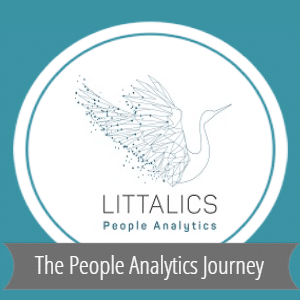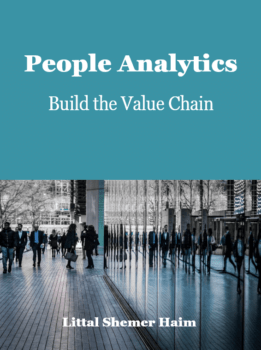The People Analytics professional community is evolving. One of its remarkable qualities is the open-source culture that characterized many of its members. While datasets, analytics, and insights are usually restricted from sharing, the experiences, resources, and advice are generously shared.
I had the pleasure of meeting Nicole Lettich, Sr. Specialist in HR Metrics and Analytics at Nasdaq, and discussing her development and success in her role. Our conversation inspired me to list the ABCs of People Analyst’s success, starting with Autodidact habits, Business understanding, and Coding skills.
Career path into People Analytics
LSH: Tell us about your background, professional journey, and current role.
NL: I have a bit of an unusual background because my career hasn’t exactly followed a linear path. I have an English degree but spent much of my early career working in marketing analytics in the financial services industry. I held roles on both the Acquisition and Retention sides of the business. I was responsible for A/B testing campaigns and building marketing mix models, plus I got to participate in Six Sigma projects which taught me a lot about process improvements. After doing that for several years, I eventually had the opportunity to open my own business. I learned so much through that experience. I broadened my analytical skillset to include business and financial analysis techniques and got my first exposure to overseeing Human Resources. That role enabled me to see the impact that my policies had on business outcomes.
Ultimately, I decided to transition back into being an employee, so I started working as a Staff Accountant and planned on sitting for the Certified Management Accountant certification. The owner asked me about building out Human Resources since there was never a dedicated person in the role, so I accepted the challenge and gradually stood up the function. I oversaw a small team responsible for HR, overhead and property accounting, and payroll. Since I was operating in whitespace where nothing previously existed, I was able to create analyses using information from all of our different systems.
Now, I’m the first hire on the Organizational Insights & Analytics team at Nasdaq. When I joined, my manager and I went on a listening tour to understand the needs of our internal clients, and we used that information to help us develop the roadmap. It’s an ideal role for me because I enjoy translating business needs into tangible outcomes. It’s again a place where I have the opportunity to help create something that didn’t previously exist.
LSH: Let’s dive deeper into your role: What business questions are you involved in, and who initiates them?
NL: I work closely with our Organizational Strategy Leaders and CoEs to answer questions for key decision-makers. One of the critical pieces of work produced is quarterly reports used during business reviews. We use these to provide business leaders with organizational health metrics and drive workforce planning discussions. These reports synthesize HR data from different sources to give leaders a holistic view of their recruiting, talent management, and DE&I processes and outcomes. I also partner with members of the different CoEs to understand how we can leverage data from external sources to provide insights to leaders.
Coding for People Analytics
LSH: Describe the tools that you use and your outputs. How do you leverage coding skills in your daily work?
NL: I primarily use several key python libraries for data management, analysis, and visualization. Pandas is a library for working with tabular data. I use it to import and manipulate data from flat files or databases. I work with Statsmodels, Sklearn, and Scipy for statistical analysis. I also use Matplotlib and seaborn to produce the visualizations for my PowerPoint reports. But, I will also use bokeh to produce interactive reports or dashboards depending on the requirements.
LSH: Let’s explore further the advantage of coding. How did coding skills contribute to your success?
NL: Learning to code is highly beneficial because you have the flexibility to create customizable solutions, and you can quickly produce and share insights. I began coding when I took over the tax abatement process at my previous employer. I inherited an entirely manual process. I looked at the process design to figure out where the roadblocks were. I knew the approach had to ultimately be automated so it would scale as we took on larger projects. Plus, we needed a way to report on KPIs and metrics related to staff capacity. I coded a data entry form workflow and automated reporting using VBA for my proof of concept and then continued to refine it using SQL and python.
In my current role, I most recently applied my coding skills to build a Markov analysis to show the impact of hiring and attrition on the gender composition of the workforce. I became familiar with this type of analysis when studying for the SPHR. However, I learned to build the model using Excel without any interactivity. I now use NumPy, pandas, bokeh, and a few other Python libraries to create this model as an interactive report with slicers that the end-users can use to assess impact.
Learning on the job
LSH: How do you learn on the job? What are the barriers, and how to overcome them?
NL: Fortunately, we have a very robust Learning & Development platform at Nasdaq – I have access to tools that help me learn on the job. One of the things that drew me to the company is that they encourage the 70/20/10 learning principle. 70% of learning is on the job, 20% through mentoring, and 10% by formal training. I’ve been fortunate to work in organizations where people are open to knowledge sharing and are willing to help if you get stuck on a concept or a technique.
LSH: What should be the learning goals for people Analysts? What are the crucial skills for future success?
NL: The most important skill for people analysts is to know how to translate business problems into analytical questions. They must have a deep understanding of the business, its strategies, and objectives to produce an analysis that will have an impact. When it comes to technical skills, they should know how to choose the correct analysis, deal with data issues, and communicate results and complex subjects to individuals of varying technical expertise. I’m, of course, a firm believer in the importance of knowing how to code.
Working with HR Professionals
LSH: What is, in your opinion, the most prominent challenge in the HR sector regarding data analytics?
NL: We’re in an exciting time where people analytics isn’t a nice to have but is a business necessity. However, while it’s satisfying to see that progress, I think that many HR departments don’t have access to financial data, so it can be challenging to quantify the impact of people analytics projects on business outcomes.
LSH: What would you recommend to HR practitioners who want to become more data-driven professionals?
NL: Foundational data literacy is a critical first step in becoming more data-driven. Understanding the basics will help you become more comfortable interpreting data and becoming more evidence-based. Statisticsbyjim.com is a site that communicates statistical topics in a very approachable way. And the StatQuest YouTube channel features explainer videos on various statistics and data science topics in bite-size pieces that help build up your confidence level. Even if the end game isn’t to become a practitioner, you can have more productive conversations with HR tech vendors and your People Analytics team if you better understand how these techniques work. Lastly, I recommend reading lots of case studies because they’ll help you conceptualize what’s possible.
LSH: Thank you, Nicole! It was an inspiring conversation. I look forward to following your work and finding the next opportunity to explore how Autodidact habits, business understanding, and coding skills lead to People Analytics practices that impact the organization.







